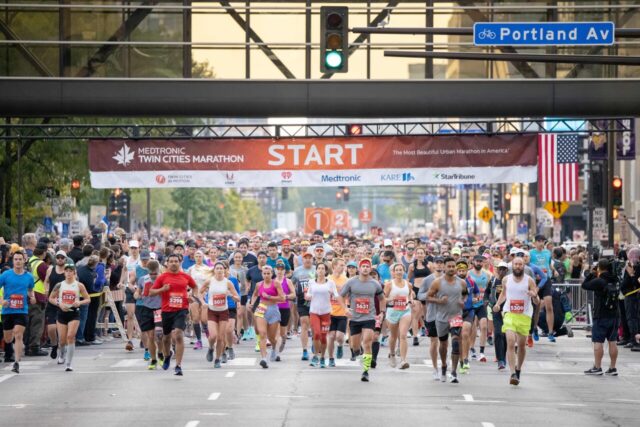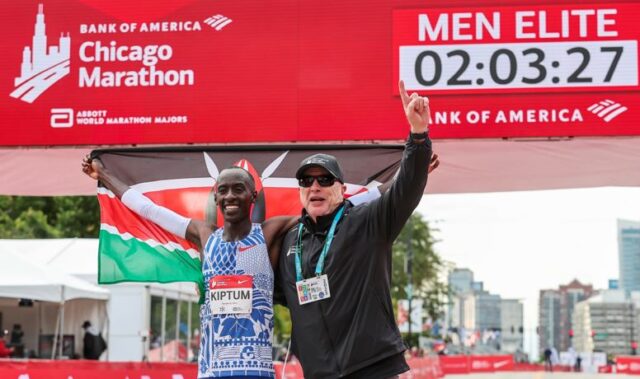Midsize Business

Insights from the 2023 Cancellation of the Medtronic Twin Cities Marathon
Thousands of runners were ready to convene at the starting line of the Medtronic Twin Cities Marathon on Sunday, October 1, 2023. But what was supposed to be a day of triumph, endurance, and personal records turned into an unexpected turn of events as Black Flag weather conditions led to the race being canceled hours before it was set to begin.
The cancellation was a big news story in Minneapolis – as well as in the running community nationally - and left many participants, who were trained and ready to race, disappointed. Yet, out of the chaos emerged a wealth of insights and lessons that are being shared throughout the running industry. Critical takeaways on preparedness, communication, and more are beneficial to events of all sizes.
After presenting an in-depth case study on the cancellation experience at the 2024 Running USA Industry Conference in Orlando (view the presentation document here), the Twin Cities in Motion team, which produces the marathon, was generous enough to recap some of their top-level lessons for our Running USA readers. Here are their thoughts. Thanks to Eli Asch, Charlie Mahler and Jessie Sand for their efforts on this summary:
Q: What changes have you made to your pre-event process for this year’s marathon based on last year’s cancellation?
TCM Communications Team: In hindsight, I think most of us would say we should have been a little more prepared for the “cancel” option than we were. Our focus throughout the week was making sure the race could be run safely in what we expected to be really difficult conditions. Our messaging and planning were focused, naturally enough, on raising awareness of the dangers and outlining what we were doing to make things safer and what participants needed to do to protect themselves. We knew all along cancellation could be in the cards and it’s not like we got caught by surprise, but we spent most of our limited time, human resources, and bandwidth on the “go” situation and making it safe. Speaking for the comms side, we probably should have put a bit more attention at the start of the week into potential cancellation messaging and post-cancellation talking points/media strategy, so we weren’t scrambling as much as we were in the wee hours of Sunday morning.
TCM Operations Team: A lot of what we did really affirmed our preparedness plan—we had a planned cadence of pre-race Interagency Team and Crisis Comms meetings that got most of the right people in the room when they needed to be in the room to make decisions and review plans and comms, and we utilized that well. Out of those processes we were able to establish and then reaffirm our EAS flag status and thresholds, confirm additional medical resources, and mostly—although admittedly not always perfectly, as perfect is a high bar under any circumstances, let alone challenging ones—keep people informed. As related to our medical operations, there are a couple things we had planned for the extreme conditions that we didn't get to execute on—like establishing with each Aid Station Medical Team that they were able to be reimbursed up to a certain dollar amount for any additional ice or heat-related supplies they bought during the day, rather than having a single re-supply team running ice all over the course—that we've established as "keepers" for future years. The biggest takeaway for us is that we have had a long-established "Rules & Games" Committee time of 5:00am on race morning. That was planned more for "acute" incidents (like lightning, or a late-breaking course-altering event), but for a known risk like heat, we would move that meeting up in future years to make any early morning call a little earlier. This past year, we told runners that they would hear from us with a final update at 5:30am (with our 10 mile starting at 7:00am) and we hit that timeline, but in future years, if we have a planned final race morning review it will be moved up some amount of time (likely to 4:00am) so that we can communicate to runners some amount earlier (ideally before 4:30am).
Smaller things include making sure certain smaller internal groups have tighter comms plans through pre-opened group texts or other tools to make comms as close to synchronous as possible.
Q: Have you made any adjustments to your marketing or communications strategy to address runner concerns or fears?
TCM Communications Team: We addressed these concerns to the best of our ability after the event, and we feel we did so extensively--on podcasts, interviews with NPR/MPR, the Wall Street Journal, the Star-Tribune, and directly to our runners. We made our runners whole through a refund mainly funded by our cancellation insurance and were able to offer them a special window to register early for next year. Now it's about moving forward—yes, with preparedness plans in place for the future and a readiness (including talking points) to address concerns if they arise again in the future. If a participant wants assurances that we won’t have to cancel again, that’s an unrealistic expectation. While there are small and specific things that we would do differently in future years, we would cancel again under the same circumstances. We have a responsibility for the safety of participants, volunteers, and the viability of community safety resources.
Q: Have you added any external support resources for weather-related issues to this year’s marathon ramp up process?
TCM Operations Team: We already had such strong support from our National Weather Service- Twin Cities Office and Hennepin County Meteorologist in real-time, 24 hours a day. Additionally, they have connected us to our Minnesota Department of Natural Resources Climatologists, who are conducting a long-term climate trends study for us that could be a factor in future decisions like a potential date change. We are working on a partnership with several other major US marathons to share resources like WBGT thermometers on race day, and are also looking into a dedicated contract resource that would be able to support race week coordination solely of our partner permitting and safety agencies under any conditions (from perfect to challenging), to assure that they remain informed at all times and are able to support any type of incident that arises. We also ID'd that one of the gaps in our comms plan was that we didn't have a trusted and tested mass text tool to inform most people where they go first for info—their smartphone—and our Marketing & Comms team is leading efforts to assure that we have one that we have tested and that can appropriately segment messaging to both internal and external groups by this upcoming year's marathon weekend.
Q: Small events (3,000 runners and under) are a very large part of our Running USA network. Are there any tips/suggestions that the TCM team can provide that would help small events plan and prepare for inevitable weather-related issues?
TCM Communications Team: I think tabletop exercises among staff and key volunteers are incredibly helpful, both for surfacing and examining varied weather and other crisis situations, but also for seeing how different members of the team will interact on such matters. If there’s a regular meeting where key players are in attendance, adding 15 minutes to discuss a scenario is good to build the team’s “crisis muscles.” In addition to that, I’d say don’t be shy about reaching out to larger organizations for insights, messaging templates and wisdom from experiences they may have had. And, going into an event, scheduling meeting times throughout race week for members of the crisis team to meet. The meetings may not be needed in the end, but it’s easier to cancel meetings on race week than wedge them into an already packed and chaotic schedule if a crisis comes up.
TCM Operations Team: First, adopt EAS flags as a communication tool. It's the clear, industry-standard way of communicating safety information of all kinds about your event. If you have any doubts, consult with a medical professional—hopefully your Medical Director—about what level is appropriate in advance of your event. Also, it will vary market to market, but your city, county or state may have resources that you're not even aware of that would be able to help you in a crisis—National Weather Service, Office of Emergency Management, college or university meteorology programs, etc. Establishing relationships with those groups before you're in crisis goes a long way to establish trust and credibility that is greatly needed when and if you do have a crisis and need their support. Having a pre-planned check-in with them 5-14 days in advance of the race—we have what we call the "Interagency Public Safety Race Week Kick-off Meeting" over coffee and a light breakfast from 9-10am Monday morning of race week—is helpful to both keep them informed and get any updates from them that you might need to have. Additionally, having pre-planned communications written in advance—that may just need a few, final "Mad Libs"-style detail additions—and email lists to all relevant groups--participants, day-of volunteers, your committee, sponsors, vendors, staff, and Board—pre-loaded into your email tool will save precious time in a crisis.
Q: Anything else you would like to add that fellow events can learn from?
TCM Operations Team: Don't try to predict the unpredictable. With the chance of impending bad weather—and especially potentially event-altering or -cancelling-ly bad—everyone is going to be asking you questions that you can't know the answer to: "Will you cancel?" "What will the weather be?" "What will happen if you do cancel—will we get a refund?" In those moments, you have to be empathetic, but you can't promise anything you aren't 100% certain you will deliver on. The key things to let folks know are your current status—this is where the EAS flag will come in handy—and when they will receive their next update from you. After an event cancellation, you are never going to make everyone happy—one of the things that's so great about running is how deeply invested our participants are. But do what you can to put participants first in ways both big and small that you can systematically support—mail medals, or if you can't mail them have runners come and pick them up. If people didn't get to go to your beer garden, see if your brewery partner will host an event at a local bar. And keep people —including your participants, but also your other key stakeholders—updated about what your plans are, or—if you don't know what those plans are yet—when they should expect to hear from you next.
It's a hard process, but if you're empathetic, put your runners first, and don't overcommit yourself to things you can't deliver on, you will get through it and be able to come back strong—admittedly maybe with some battle scars—in future years.
TCM Communications Team: Be prepared for the effort needed during the post-cancellation days and weeks. Cancellations have a longer “tail” than completed events with unexpected challenges like checked gear, medal distribution, credit finalization, overflowing warehouse, etc. Be mentally ready for the final chapters of the crisis. It wasn’t until nearly a month after the race, once our insurance situation was finalized, that the 2023 cancellation felt “mostly over” for us.

Remembering Kelvin Kiptum: An Interview with Carey Pinkowski
When Carey Pinkowski got news that Kelvin Kiptum had been in a car accident, he didn’t let himself fear the worst. “Maybe a bruised rib,” he thought. Just four months earlier, Kiptum had leapt into Pinkowski’s arms after breaking the marathon world record at the Bank of America Chicago Marathon where Pinkowski serves as the Executive Race Director. That week, the world record had just been ratified by World Athletics. Still left to wonder what had just happened some eight thousand miles away in Kenya, Pinkowski thought, “Maybe he has to take some time off.” Moments later, Pinkowski’s phone rang. It was a friend from Nike. Kiptum and his coach Gervais Hakizamana were dead.
***
Pinkowski first saw Kelvin Kiptum at the 2023 TCS London Marathon. There, the 23-year-old Kenyan showed the world that his 2:01:53 debut marathon performance in Valencia was no fluke. That day, he would win easily in 2:01:25, the second fastest time in history. Then, the question wasn’t If Kiptum was going to break the world record, but where he was going to break it.
There for work and to watch his daughter run, Pinkowski saw Kiptum run by him at mile 15. “I turned to my wife and I go, ‘I gotta get this guy. I've never seen anything like it before,”’ Pinkowski recalls. “He kind of took my breath away. I was 10 yards from him. I was like, ‘holy cow, this guy is special.’”
Although known for its fast course, welcoming to pacers and generally favorable weather conditions, Chicago had not seen a men’s world record since Khalid Khannouchi ran 2:05:42 in 1999 (the women’s world record was set in Chicago by Brigid Kosgei in 2019, but has since been broken). The last eight world records, accounting for nearly four minutes of progression, had fallen in Berlin, another famously fast race held just one week before Chicago. Pinkowski knew that was his fiercest competitor to host a new men’s record. He relied on his long-time friendship with Kiptum’s manager, Marc Cortsjens, to recruit Kiptum to come to the United States.
“I think he was keenly aware of the course and the history and the tradition here. And he wanted to be part of that,” said Pinkowski. A Kenyan man had won Chicago 18 times prior to 2023 - legends like Robert Cheruiyot, Moses Mosop and Eliud Kipchoge. “There was no ‘maybe we will talk to Berlin.’ No, Chicago is where we want to go.”
If you were expecting a bidding war over appearance fees, prize money and incentives, Pinkowski says that wasn’t the case, casually referring to securing the most exciting young athlete in a generation as “easy” to work with. While Pinkowski didn’t get into specifics on elite budgets, he insisted that the top priority for his team and for Kiptum was coming to Chicago to run fast. “And then, everything kind of falls in place,” he said. The hard work was preparing the team at Chicago Event Management and the City of Chicago to potentially host a historic performance.
Although he was just 26-seconds shy of Eliud Kipchoge’s 2:01:09 after his London victory, Pinkowski says Kiptum and his team never engaged in any conversations about breaking the world record in Chicago. Kiptum, he said, simply wanted to run fast. Even at the pre-race press conference, Kiptum would only tell reporters he wanted to break the course record of 2:03:45; simple for a man who’d never run over 2:02. But Pinkowski, who’s spent more than three decades at the helm of Chicago, knew it wasn’t simply a possibility. It was the most likely outcome. He started spreading the word. In a meeting with city services, Pinkowski told police officers, emergency personnel, sanitation employees and even the Mayor’s team that Kiptum was the best he’d ever seen and he was going to break the World Record in Chicago on October 8, 2023.
In the marathon, the biggest factor that can make or break an athlete’s day is the weather, obviously beyond anyone’s control. Pinkowski was more than confident in his course. It’s responsible for three of the top five fastest women’s marathon times in history and has made Khannouchi, Steve Jones, Catherine Ndbera, Paula Radcliffe and Kosgei world record holders. In fact, in the past 40 years Chicago is one of only four marathons where world records have been set by men or women. Along with Berlin, the others are London and Rotterdam. Chicago is also where Emily Sisson set the American record in 2022.
Pinkowski points out that Chicago is an especially athlete-friendly event. Elite athlete manager Tracey Wilson is dialed in on athletes’ dietary needs, sleep schedules and race-week training requirements. She and her team focus on ensuring the last two days put as few outside pressures on the athletes as possible. That’s part of why the athlete hotel, hospitality suite and press conferences are all in the same hotel, just steps away from the start line.
“It's about athletic competition first and foremost,” said Pinkowski. “These athletes are coming to Chicago to run a marathon. If they make history, it far exceeds anything you can create on social media or whatever. Not that we still don't continue to do those, those are excellent, excellent tools to get our messaging out for our sponsors or information to our participants. But at the core of what we do is recognizing that there's a lot invested in this and that we need to make sure that these guys, men and women, these individuals are in the right place.”
The Chicago team also assembled an international athlete field that would give Kiptum a chance of having people to run with. They included defending Chicago champion Benson Kipruto, Olympic and World Bronze Medalist Bashi Abdi and most notably, Daniel Mateiko, Kiptum’s rabbit in London through 30K who was now making his own marathon debut. Additionally, Wilson and Pinkowski worked with Kiptum’s team to employ a team of four pacers in case Kiptum’s pace was too quick for his competition.
Pinkowski’s bold prediction to the city served a mission critical purpose. He made the same statement to volunteers and course staff. An errant vehicle, a misplaced cone, an unprepared water stop could all cost Kiptum precious seconds and a world record for not only Kiptum, but for the city. The result was a well-oiled machine.
“It was probably one of the best organized events of all the years that we've done it,” Pinkowski said.
Any concerns about the weather conditions evaporated when Pinkowski stepped outside on race morning. He had been getting hourly updates from the team’s meteorologist. “They just kept getting better and better and better. Sometimes they get worse and worse and worse, but they just kept getting better,” he said. It was a dry, cloudy 46 degrees with no wind when the gun went off. “Today’s the day,” Pinkowski thought.
Kiptum made it clear he was prepared to make history in the early miles of the race. He ran his first 5K in 14:23 and by 10K, had dropped everyone except Mateiko and his pacers. The pair reached the half marathon behind world-record pace, but Kiptum lived up to his reputation of finishing fast. As he made the final turn onto Columbus Drive, Kiptum began to sprint, pumping up the already roaring crowd. By now, everyone has the finishing time memorized. 2:00:35. 34 seconds faster than Kipchoge’s record. Unable to contain his excitement, Pinkowski ran into the finish chute where Kiptum lept into his arms, an image caught by cameras from around the world.
[caption id="attachment_21931" align="aligncenter" width="300"] Chicago Marathon 2023. Photo by Kevin Morris.[/caption]
***
After the celebration in Chicago, Pinkowski never saw Kiptum again. He had planned to travel to watch him in Rotterdam this April, where Kiptum had announced he was trying to become the first person to break the two-hour barrier in a sanctioned race.
Less than a month after Kiptum’s tragic death, Pinkowski and the city have barely had time to process his historic race let alone his unexpected passing. At the time of this interview, he had just returned from the Tokyo Marathon where he said dozens of Americans came up to him to offer condolences and share their disbelief. In Chicago, everyone from race spectators to Mayor Brandon Johnson have reached out to Pinkowski and the CEM team.
“Kelvin put Chicago front and center in that we can break world records here. The residual effect of that kind of reenergized our team. It reenergized me,” Pinkowski said. “I mean, he really connected us, because we were all part of building this thing. It’s still resonating.”
***
Author and interviewer Jay Holder is the Executive Director of Running USA. Photo credits: Kevin Morris.

How to Sell Your Running Race: Tips and Considerations
Every good race director knows that timing is everything. And yet, along with many other small business owners, many race and event owners haven’t adequately trained for their own exits. In fact, Running USA’s research shows that exit planning is top of mind for race owners, with many sharing that they would like more information about exit planning and ultimately selling.
Of course, starting can be the hardest part. Especially, with so many questions to answer. When is the best time to sell an event business? How are they valued? Who might the buyers be? How long will the process take? And what might that finisher’s medal look like — the purchase price? Here are some ideas and tips to consider:
1. Get a confidential analysis of the value of your business
Whether you’ve got a young event, and hope to run it for decades, or if you’ve had your race for awhile, and are starting to think about what’s next, a business valuation is an essential tool. It will give you that 30,000 foot view of the business, including what it’s worth. With a professional opinion of market value from an experienced broker in hand, you get to decide what’s next: take this info, and continue to improve your event, or go to market.
2. Plug into a network of interested buyers
There are multiple types of buyers actively seeking to purchase event businesses. Individual investors, private equity firms, other race owners, non-profits, etc. But the key is finding them, and entering the marketplace in a way that protects confidentiality, and ensures you get in front of the right people. This is where working with a networked intermediary is incredibly useful. In addition to their connections, it also allows you to focus on your life and business without distraction.
3. Prep for ‘race day’ by having your house in order
Just as you wouldn’t run a half marathon off the couch (have done, don’t recommend), going to market is like race day. Financial records should be in order, tax returns filed (and not on extension), operating procedures documented, sponsorships and permits solidified, and equipment inventoried and serviced. Everything about the business will be scrutinized by a buyer. Preparation is 90% of success.
4. Give yourself plenty of time — and don’t end up in the med tent
Business owners often underestimate the time required. It typically takes 3-9 months to sell a business. So it’s more of a marathon than a 5K. There are many steps to a business sale: following the evaluation, there is the marketing of the business, screening and meeting with buyers, negotiations, and finally, deal facilitation and closing. Each step is highly nuanced, but the goal is the same: get you to the finish line with the highest result possible.
5. Timing the sale for a new owner sprint to the finish
Cash flow is KING in business sales. It is what makes all the hard work on a race worth the effort. It is also what drives a buyer to purchase a business. Running can be a great hobby, owning & operating a race is done for financial renumeration. When the registration fees start rolling in it is like Christmas Day for a race owner, it is also what pays all the accumulated bills. The best time to purchase a race is 3-4 months before the race occurs, so the buyer can learn all the administrative activities necessary to successfully execute the event. It also results in two “Christmas seasons” in less than 18 months. Compare that with someone who buys a race shortly after it is completed, that individual will receive only one Christmas in 18 – 20 months, a far less attractive scenario for investment.
6. Prioritize what you’d most like to get out of the sale — and revisit
Write down a list of the top three things you want to get out of the sale, and rank them in order of importance. For some people, that might be the financial outcome; for others, it might be legacy (such as selling it to a local runner). Later, in the sale process, you can go back to this list as a way to stay focused and centered. Ultimately, the goal is to have you look back on the transaction, five to ten years out, with a strong sense of satisfaction — knowing that you did everything you could to honor and maximize the value of what you’d built. That feeling never gets old!
About the author: Sally Bergesen is a Business Sales Intermediary with Run Broker and IBA. She helps owners of privately-held and family-owned businesses successfully sell their companies. Prior to joining IBA, Sally founded and ran Oiselle for 16 years. After selling the business, she wanted to help other entrepreneurs achieve successful exits. Sally can be reached at sally@ibainc.com or (425) 454-3052.

